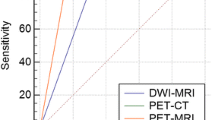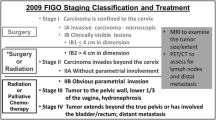Abstract
The purpose is to evaluate the accuracy of integrated FDG-PET/CT, compared with PET alone, for diagnosis of suspected recurrence of uterine cervical cancer. Fifty-two women who had undergone treatment for histopathologically proven cervical cancer received PET/CT with suspected recurrence. PET-alone and integrated PET/CT images were evaluated by two different experienced radiologists by consensus for each investigation. A final diagnosis was confirmed by histopathology, radiological imaging, and clinical follow-up for over 1 year. Patient-based analysis showed that the sensitivity, specificity, and accuracy of PET/CT were 92.0% (23/25), 92.6% (25/27), and 92.3% (48/52), respectively, while for PET, the corresponding figures were 80.0% (20/25), 77.8% (21/27), and 78.8% (41/52), respectively. PET/CT resolved the false-positive PET results due to hypermetabolic activity of benign/inflammatory lesions and physiological variants, and was able to detect lung metastasis, local recurrence, peritoneal dissemination, para-aortic lymph node metastasis, and pelvic lymph node metastasis missed by PET alone. However, tiny local recurrence and lymph node metastasis could not be detected even by PET/CT. FDG-PET/CT is a useful complementary modality for providing good anatomic and functional localization of sites of recurrence during follow-up of patients with cervical cancer.



Similar content being viewed by others
References
Larson DM, Copeland LJ, Stringer CA, Gershenson DM, Malone JM Jr, Edwards CL (1988) Recurrent cervical carcinoma after radical hysterectomy. Gynecol Oncol 30:381–387
Chou HH, Wang CC, Lai CH (2001) Isolated paraaortic lymph node recurrence after definitive irradiation for cervical carcinoma. Int J Radiat Oncol Biol Phys 51:442–448
Niloff JM, Bast RC Jr, Schaetzl EM, Knapp RC (1985) Predictive value of CA 125 antigen levels in second-look procedures for ovarian cancer. Am J Obstet Gynecol 44:207–212
Low RN, Sigeti JS (1994) MR imaging of peritoneal disease: comparison of contrast-enhanced fast multiplanar spoiled gradient-recalled and spin-echo imaging. Am J Roentgenol 163:1131–1140
Sugiyama T, Nishida T, Ushijima K et al (1995) Detection of lymph node metastasis in ovarian carcinoma and uterine corpus carcinoma by preoperative computerized tomography or magnetic resonance imaging. J Obstet Gynecol 21:551–556
Forstner R, Hricak H, Powell CB, Azizi L, Frankel SB, Stern JL (1995) Ovarian cancer recurrence: value of MR imaging. Radiology 196:1131–1140
Connor JP, Andrews JI, Anderson B, Buller RE (2000) Computed tomography in endometrial carcinoma. Obstet Gynecol 95:692–696
Topuz E, Aydiner A, Saip P et al (2000) Correlation of serum CA125 level and computerized tomography (CT) imaging with laparotomic findings following intraperitoneal chemotherapy in patients with ovarian cancer. Eur J Gynecol Oncol 21:599–602
Cook GJ, Maisey MN, Fogelman I (1999) Normal variants, artifacts and interpretative pitfalls in PET imaging with 18-fluoro-2-deoxyglucose and carbon-11 methionine. Eur J Nucl Med 26:1363–1379
Kostakoglu L, Agress H Jr, Goldsmith SJ (2003) Clinical role of FDG PET in evaluation of cancer patients. Radiographics 23:315–340
Beyer T, Townsend DW, Brun T et al (2000) A combined PET/CT scanner for clinical oncology. J Nucl Med 41:1369–1379
Park DH, Kim KH, Park SY, Lee BH, Choi CW, Chin SY (2000) Diagnosis of recurrent uterine cervical cancer: computed tomography versus positron emission tomography. Korean J Radiol 1:51–55
Sun SS, Chen TC, Yen RF, Shen YY, Changlai SP, Kao A (2001) Value of whole body 18F-fluoro-2-deoxyglucose positron emission tomography in the evaluation of recurrent cervical cancer. Anticancer Res 21:2957–2961
Ryu SY, Kim MH, Choi SC, Choi CW, Lee KH (2003) Detection of early recurrence with 18F-FDG PET in patients with cervical cancer. J Nucl Med 44:347–352
Nakamoto Y, Eisbruch A, Achtyes ED et al (2002) Prognostic value of positron emission tomography using F-18-fluorodeoxyglucose in patients with cervical cancer undergoing radiotherapy. Gynecol Oncol 84:289–295
Havrilesky LJ, Wong TZ, Secord AA, Berchuck A, Clarke-Pearson DL, Jones EL (2003) The role of PET scanning in the detection of recurrent cervical cancer. Gynecol Oncol 90:186–190
Lai CH, Huang KG, See LC et al (2004) Restaging of recurrent cervical carcinoma with dual-phase [18F]fluoro-2-deoxy-D-glucose positron emission tomography. Cancer 100:544–552
Chang TC, Law KS, Hong JH et al (2004) Positron emission tomography for unexplained elevation of serum squamous cell carcinoma antigen levels during follow-up for patients with cervical malignancies.-a phase II study. Cancer 101:164–171
Yen TC, See LC, Chang TC et al (2004) Defining the priority of using 18F-FDG PET for recurrent cervical cancer. J Nucl Med 45:1632–1639
Chung HH, Jo H, Kang WJ et al (2007) Clinical impact of integrated PET/CT on the management of suspected cervical cancer recurrence. Gynecol Oncol 104:529–534
Sironi S, Picchio M, Landoni C et al (2007) Post-therapy surveillance of patients with uterine cancers: value of integrated FDG PET/CT in the detection of recurrence. Eur J Nucl Med Mol Imaging 34:472–479
Shim SS, Lee KS, Kim BT et al (2005) Non-small cell lung cancer: prospective comparison of integrated FDG PET/CT and CT alone for preoperative staging. Radiology 236:1011–1019
Bristow RE, Del Carmen MG, Pannu HK et al (2003) Clinically occult recurrent ovarian cancer: patient selection for secondary cytoreductive surgery using combined PET/CT. Gynecol Oncol 90:519–528
Belhocine T (2004) 18F-FDG PET imaging in post-therapy monitoring of cervical cancers: from diagnosis to prognosis. J Nucl Med 45:1602–1604
Acknowledgments
We thank the staff of the department of obstetrics and gynecology, especially Ichio Fukasawa and Noriyuki Inaba, for recruiting patients. We also thank Kennichi Kobayashi, Kazufumi Suzuki, Kaoru Ishida, and Tomoyuki Sakamoto for their excellent technical assistance and generous support.
Author information
Authors and Affiliations
Corresponding author
Rights and permissions
About this article
Cite this article
Kitajima, K., Murakami, K., Yamasaki, E. et al. Performance of FDG-PET/CT for diagnosis of recurrent uterine cervical cancer. Eur Radiol 18, 2040–2047 (2008). https://doi.org/10.1007/s00330-008-0979-9
Received:
Revised:
Accepted:
Published:
Issue Date:
DOI: https://doi.org/10.1007/s00330-008-0979-9




